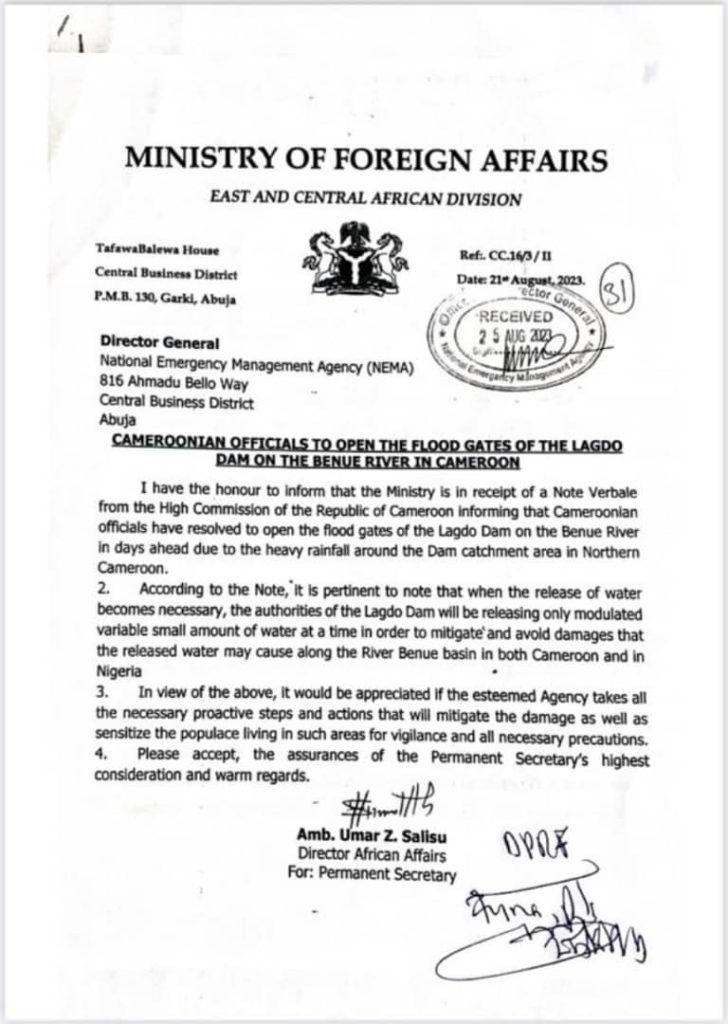Minister of Water Resources and Sanitation, Professor Joseph Utsev has confirmed the release of excess water from the Lagdo Dam by Cameroonian authorities but says says this is being done in regulated measure and pattern such that there is no threat to life in Nigeria.
Professor Utsev however says the Nigerian Government is closely monitoring developments and advises governments of states with communities along the bank of River Benue and its tributaries to take precautionary measures by evacuating the residents to protect lives and property.
Below is the text of the statement by the Minister and the Minister of State, Bello Goronyo over threats of flooding in Nigeria.

Text of a Press Statement on Response to Potential Flooding in Nigeria by the Honourable Minister of Water Resources and Sanitation, Engr. Prof. Joseph Terlumun Utsev, FNSE, FNICE, FNIWE, FICEN, FIIA, and the Honourable Minister of State for Water Resources and Sanitation, Bello Muhammad Goronyo, Esq. during joint Press Briefing on Friday, August 25, 2023 at the Conference Room of the Ministry .
- Hydrological Observations: The Nigeria Hydrological Services Agency, NIHSA has noted an increase in the volume of flow along the River Benue system, registering a flow level of 8.97 meters as of today. This is compared to a flow level of 8.80 meters on the same date in 2022. Meanwhile, the flow level on the River Niger system remains stable, with the level of the River Niger at Niamey, Niger Republic, standing at a normal level of 4.30 meters. Reports from inland dams including Kainji, Jebba, and Shiroro also indicate a consistent flow regime.
- Situation at Lokoja: Despite the heightened flow volume along the River Benue system, the flow situation at the confluence of the Niger and Benue rivers in Lokoja, Kogi State, remains within normal parameters. The flow level at the monitoring station downstream of the confluence records 7.80 meters today, compared to 8.24 meters on the same date in 2022.
- Preparedness Measures: Recognising Nigeria’s downstream position in relation to the nine-member countries of the Niger River Basin, it is important to acknowledge the period of heavy rainfall, flooding, and flood-related disasters that typically occur during July, August, September, and October. Dam water releases are integral to safeguarding dam integrity and mitigating flooding in adjacent communities.
NIHSA has however maintained a professional and organizational relationship with Cameroon’s National Hydrological Services to exchange information on water releases,
- Call to Action: In light of the aforementioned factors, it is imperative for all levels of government – federal, state, and local:
To heighten the level of preparedness and deploy appropriate measures to minimise the potential impact of flooding during the peak of the rainy season there should be sensitisation of the general public by the States on the need for people living along the river banks to relocate to higher grounds during this peak period of rainfall.
States and Local Governments should intensify efforts in clearing blocked drainages and also construct new ones where they do not exist. Removal of illegal structures constructed within the floodplains.
The general public, especially road users, should desist from walking or driving through any pool of water or flood.
- As at today, there is no threat to lives and properties, especially those states that are contiguous to Rivers Niger and Benue.
(Editor: Terverr Tyav)








